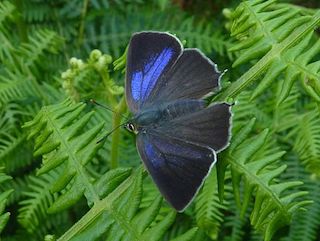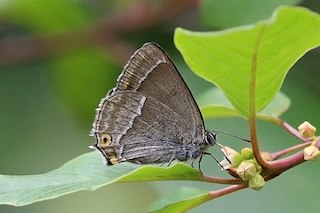 This pretty butterfly is not uncommon, but hard to spot as it spends most of its time flying at the tops of oak trees. You might see one in July to August, when they occasionally come down to feed on bramble nectar; they have been seen at Erisey Barton on The Lizard.
This pretty butterfly is not uncommon, but hard to spot as it spends most of its time flying at the tops of oak trees. You might see one in July to August, when they occasionally come down to feed on bramble nectar; they have been seen at Erisey Barton on The Lizard.
Photo: Sharp Photography (via Wiki Commons)
Scientific name: Favonius quercus
Cornish name: ‘Tikki-dui’ is the general word for butterfly
What to look for:
• Colouring: Males have purple-sheened upper wings with black edges, while females are less bright, but with a purple patch on the forewings (see upper photograph below). Underwings of both sexes are grey with a white line, and orange spots on the hindwing.
• Size: Wingspan: Male – 33-40mm; female – 31-38mm.
• Where: Mature oak trees in woods and hedges. Distribution ranges from southern England, through the Midlands and into the south of Scotland.
• When: Mainly July and August
• Similar species: None – the purple colouring of the upperwing is distinctive.

If you happen to be walking through an oak woodland on a sun-filled early evening in the height of summer, then you should keep an eye on the canopy above. You are not looking for birds, but for one of our loveliest butterflies: the Purple Hairstreak. With a wide distribution across southern England, this is our most common Hairstreak but, as it spends most of its time high in the branches of oaks, feeding on honeydew, it is somewhat cryptic. You might be fortunate and spot one fluttering down to nectar on bramble, but if you are seeking them out, a pair of binoculars coupled with sharp eyes is recommended. From below, they look almost silvery as they fly between oak branches.
 Purple Hairstreaks are most active in the early evening on sunny days. The adults are on the wing in July and August. The females lay their eggs, either singly or in pairs, at the very tip of oak branches. When the caterpillars hatch the following spring, they burrow themselves into an oak bud to feed until their first moult. They then emerge and make themselves a silken protective cocoon at the base of a bud and continue feeding, before moving to ground level to form a chrysalis in June.
Purple Hairstreaks are most active in the early evening on sunny days. The adults are on the wing in July and August. The females lay their eggs, either singly or in pairs, at the very tip of oak branches. When the caterpillars hatch the following spring, they burrow themselves into an oak bud to feed until their first moult. They then emerge and make themselves a silken protective cocoon at the base of a bud and continue feeding, before moving to ground level to form a chrysalis in June.
Did you know…?
…This is the only Hairstreak butterfly in the UK that basks with its wings open.
…The caterpillars only feed at night.
More information and references:
Newland, D., Still, R., Swash, A. and Tomlinson, D., 2002. Britain’s Butterflies. A Field Guide to the Butterflies of Britain and Ireland (third edition). Princeton University Press, Oxfordshire.
Published: September 2017
Author: Amanda Scott
Photos: Upper: By Hildesvini [CC0]; Lower: By Charles J Sharp (Sharp Photography) [CC BY-SA 4.0]. Both images via Wikimedia Commons
